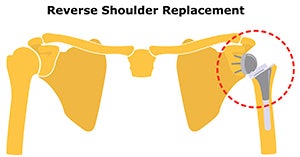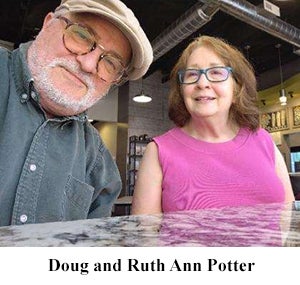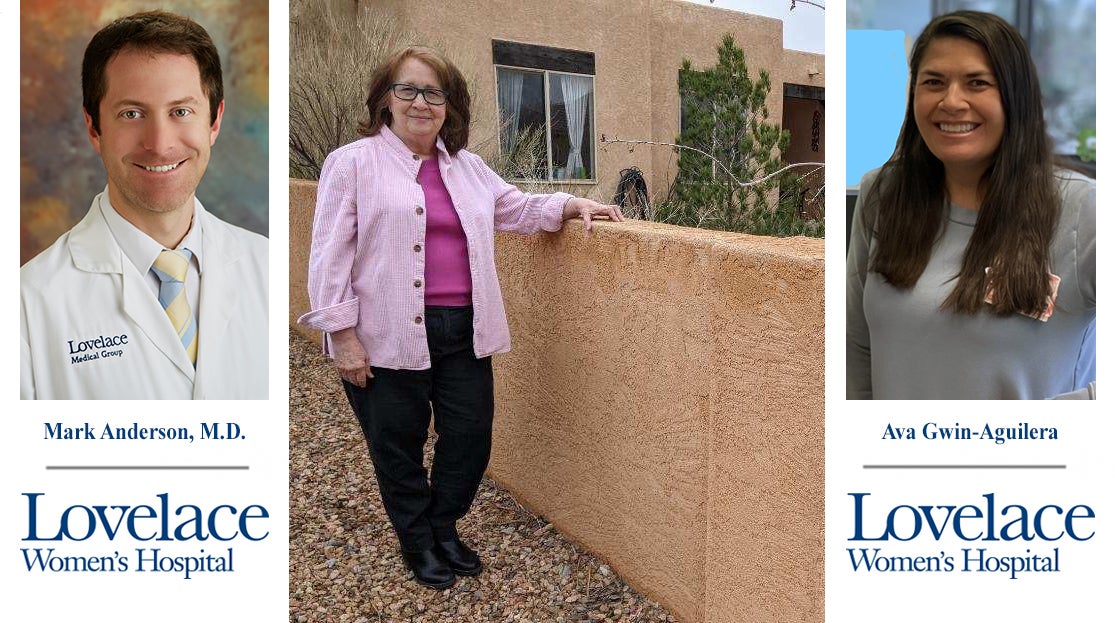Sometimes accidents just happen.
For Ruth Ann Potter, 70, it didn’t matter whether Poncho, her big, black Labrador was to blame. What mattered most was that she had quick access to excellent medical care for her injuries.
“About three years ago my husband Doug and I were walking Poncho through our neighborhood in Rio Rancho,” Ruth Ann recalled, “when a rat ran in front of our garage door. Poncho took off and I started running and falling after him, as his leash was wrapped around my left arm.”
Ruth Ann crashed into the cinder block wall that encircles their front yard and fractured her left humerus (upper arm bone), as well as breaking parts of her shoulder.
“I don’t blame Poncho. I’m just glad I didn’t smash my head into the wall. It could have been a lot worse,” she said.
Reverse shoulder replacement surgery
Ruth Ann took her first ambulance ride to the emergency room at nearby Lovelace Westside Hospital where she met Mark Anderson, M.D., an orthopedic surgeon with Lovelace Medical Group who specializes in upper arms and hands.
He recommended that Ruth Ann have reverse shoulder replacement surgery to correct the damage to her shoulder and humerus.
Most replacement surgeries that involve a damaged shoulder joint are standard surgeries because the muscles and tendons around the shoulder are still intact. In standard surgeries, the head of the humerus (the “ball”) is replaced, as well as the “socket” area at the end of the scapula.

In that surgery, a ball is attached to the end of the scapula and a concave “socket” is attached to the end of the humerus. This configuration aids the patient by providing additional flexibility when using that arm.
Rehabilitation
After surgery, Ruth Ann met with Dr. Anderson, who told her that there was some nerve damage in her shoulder area where the five major nerve branches are located. Specifically, Ruth Ann had some damage in the medial, radial and ulnar nerves.

A couple of days after surgery, Ruth Ann met with Occupational Therapy (OT) specialist Ava Gwin-Aguilera. She wanted to assess Ruth Ann’s injuries in order to plan the rehabilitation program.
“I started the rehabilitation program a couple of weeks after the surgery with Ava at the Lovelace Westside Hospital Clinic location,” Ruth Ann said. “I followed Ava when she moved to the Lovelace Women’s Hospital Outpatient Rehabilitation Hand and Upper Extremity Clinic. Doug drove me there once a week for nearly two years. Now I visit Ava once every three weeks.”
During the initial rehabilitation sessions, the focus was on getting Ruth Ann’s strength and flexibility back in her arm and shoulder. She would lie on a bench and push a weighted bar above her head. She also trained on an exercise bike and a series of pulleys to improve the range of motion in her left shoulder.
“Ava is extremely knowledgeable about the anatomy and nerve and muscle function of my hand and arm,” said Ruth Ann. “She is an excellent communicator and a very caring professional. She helped make a serious medical situation much more comfortable and less scary.”

“Ava regularly communicates with my surgeon, Dr. Anderson, to coordinate care for me,” said Ruth Ann. “The nerve function of my medial and radial nerves has returned and the ulnar nerve has healed to the level of my wrist. Ava said it could take three years for the nerve function to fully heal.”
Ruth Ann’s ring finger and little finger on her left hand remain bent in a “claw” position, as she can’t straighten them on their own. So every day while she’s watching TV, she keeps the ligaments flexible by using her other hand to straighten out the fingers.
“If I don’t do that, even when the ulnar nerve function returns, the fingers will be frozen in that position. So, as we approach the third year since my injury, I am keeping the fingers flexible until the return of the ulnar nerve function.”
Family time
Now that her recovery from shoulder surgery has gone well, Ruth Ann and Doug are looking forward to traveling more often to see their daughters. Their younger daughter lives with her husband in western Massachusetts, while their older daughter and husband live in southern Florida with their 4-year-old grandson Pablo.
With the flexibility and strength nearly back to normal in her left arm and hand, “Grandma” Ruth Ann is looking forward to using both arms and hands to wrap a big hug around her grandson!
For more information about our rehabilitation services, visit our website. For a directory of the six Lovelace Outpatient Rehabilitation Clinics in the area, visit this web page.

